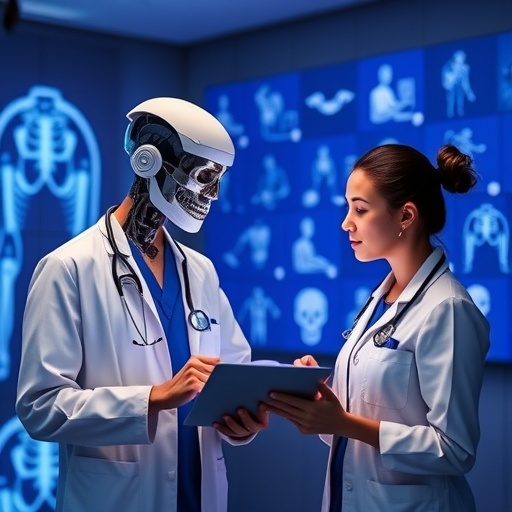In a rapidly changing educational landscape, the integration of technology into learning environments has sparked intense discussions among various stakeholders in academia, particularly in the field of medicine. One recent letter to the editor penned by N. Zhuo addresses a critical landmark study authored by Salehi et al., titled “How Medical Students Across the USA Use Generative Artificial Intelligence for Learning: A Cross-Sectional Survey.” This discourse delves not only into the findings of the original research but also highlights the significant implications these findings have for medical education and the ethical considerations that may arise when artificial intelligence becomes a commonplace tool among students.
The original study presents an insightful survey analyzing the usage patterns of generative artificial intelligence (AI) among medical students across the United States. It uncovers a nuanced landscape where students leverage AI technologies for various educational purposes, including research assistance, studying, and even clinical case preparations. Zhuo’s commentary emphasizes the importance of understanding these usage patterns in the context of rapidly evolving technological capabilities. Generative AI represents a revolutionary step forward in how knowledge is synthesized and utilized, which could ultimately reshape learning methodologies in medical education.
A salient point of Zhuo’s letter is the recognition that while generative AI offers remarkable efficiencies and support for learning, it raises questions regarding the foundational skills students might forfeit in reliance on these technologies. The convenience of having AI generate literature reviews, simulate clinical cases, or summarize complex medical information could inadvertently diminish students’ critical thinking and analytical skills, raising concerns about the capacity for independent thought. Thus, as much as the integration of AI can enhance learning, it requires a balanced approach to ensure that fundamental skills remain intact.
Moreover, Zhuo calls attention to the ethical dimensions of incorporating generative AI into medical education. Issues surrounding data privacy, intellectual property, and academic integrity are paramount. The reliance on AI tools must be navigated carefully, considering that these systems often use vast datasets to produce outputs that may inadvertently reproduce biases or inaccuracies. It poses a significant risk if medical students do not engage critically with the information generated, potentially leading to the internalization of flawed perspectives.
Through Zhuo’s lens, the conversation extends into the potential disparities that generative AI tools could introduce in the learning process. Disadvantaged students may lack access to advanced technologies, thereby widening the existing educational gap. The ability to effectively utilize these tools is increasingly relevant, yet not all institutions may have the resources to equip their students with the technology or the training required to maximize the benefits of AI. This raises a crucial question about educational equity; how can medical schools ensure that all students can harness these powerful tools without furthering systemic inequalities?
Additionally, Zhuo encourages further research into the effectiveness of generative AI as a learning aid. While the original survey provides valuable insight into usage patterns, it does not delve deeply into the actual learning outcomes associated with AI utilization. The medical education community must commit to longitudinal studies assessing not only how students interact with AI but also the resultant effects on knowledge retention, exam performance, and clinical competencies.
Another point of emphasis in Zhuo’s letter is the need for a pedagogical framework that integrates AI into curricula. As generative AI becomes increasingly standard in various educational contexts, medical schools must consider how to incorporate AI training into their programs systematically. This includes not just how to use these tools effectively but also grounding students in the ethical dimensions of AI use. A comprehensive understanding is essential for future physicians who will increasingly be required to navigate a technologically advanced medical landscape.
At the core of this interview is the recognition that generative AI is not merely a transient trend but a lasting transformation that requires ongoing adaptation from educators, students, and institutions alike. Medical educators must be proactive in creating educational strategies that incorporate AI while fostering critical thinking and ethical considerations. By doing so, they can equip future healthcare professionals with the necessary skills to thrive in a medical environment that increasingly relies on intelligent technologies.
Moreover, Zhuo points out the necessity for collaborations among stakeholders, including technology developers, educators, and healthcare professionals, to create sustainable models for AI integration into medical education. Mutual understanding and shared objectives will lead to the development of tools that are not only effective but also ethical and grounded in pedagogy. This collective effort could revolutionize how medical education is approached, ensuring that all students can benefit from advancements in technology.
As the dialogue continues, Zhuo’s letter serves as a clarion call for the medical education community to critically engage with the potentials and pitfalls of generative AI. It urges educators to adopt a forward-thinking approach that not only embraces innovation but also preserves the integral elements of what it means to be a competent and ethical physician. By addressing these multifaceted challenges head-on, we can pave the way for a new era in medical education that harnesses the power of technology while remaining committed to the principles of excellence, equity, and integrity.
In summarizing his reflections, Zhuo reaffirms the essential role that ongoing discourse plays in navigating the future of medical education amid technological upheaval. Embracing generative AI as a co-pilot in the learning journey offers endless possibilities but mandates a rigorous examination of our educational practices. As the medical community stands on the precipice of this change, it is paramount that the conversation continues, evolving alongside the technologies that are set to redefine the learning experience.
The engagement with Zhuo’s commentary and the underlying research highlights an exciting yet crucial time for medical education as we explore the incorporation of generative AI. By prioritizing thoughtfulness and rigor in this journey, stakeholders have the chance to not only harness the benefits of AI but to also shape a more equitable and effective educational framework that prepares future generations of medical professionals for challenges to come.
Subject of Research: Medical Students’ Usage of Generative Artificial Intelligence for Learning
Article Title: How Medical Students Across the USA Use Generative Artificial Intelligence for Learning: A Cross-Sectional Survey
Article References: Zhuo, N. Letter to the Editor Regarding “How Medical Students Across the USA Use Generative Artificial Intelligence for Learning: A Cross-Sectional Survey” by Salehi S et al. J GEN INTERN MED (2025). https://doi.org/10.1007/s11606-025-09971-z
Image Credits: AI Generated
DOI: https://doi.org/10.1007/s11606-025-09971-z
Keywords: Generative AI, medical education, ethical considerations, artificial intelligence, learning outcomes, education technology.
Tags: AI usage patterns among medical studentschallenges of AI in medical trainingclinical case preparation with AIenhancing medical education with technologyethical implications of AI in educationevolving educational technologies in medicinegenerative artificial intelligence in medical learningimplications of AI on medical curriculamedical education technology integrationresearch assistance through AI toolsstudent perspectives on AI in educationtransformative learning methodologies in medicine





